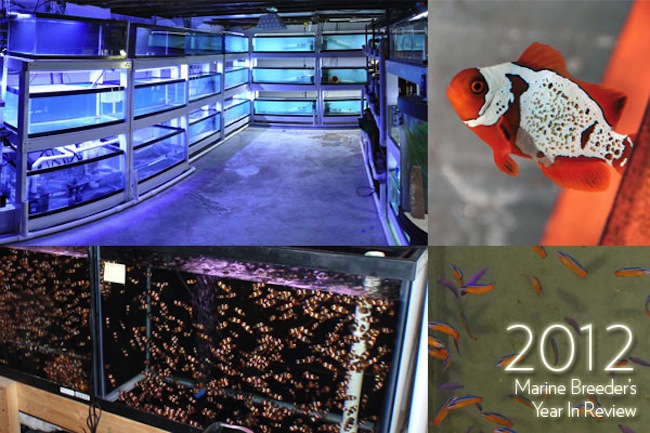As has become a tradition, it’s time again for a look back at the past year’s advances in marine fish breeding with our annual Marine Breeder’s Year In Review. (see 2010, and 2011 Part 1, and 2011 Part 2, for past recaps). Read on to learn what made 2012 another exciting year in the world of marine fish breeding.
As 2012 drew to a close, Tal Sweet, co-founder of the Marine Breeding Initiative (MBI), authored what is arguably the most comprehensive list to-date of our marine fish breeding successes. This article and list, Captive-breeding: State of the Art 2013, was published in the Jan/Feb 2013 issue of CORAL magazine, released digitally on New Year’s Eve, 2012. But more than just another “captive-bred list”, it dives even deeper to show both our historical successes, but also to catalog the actual availability of captive-bred species in 2012.

Sweet’s list is nearly exhaustive, comprised of 21 species of Angelfish, 2 Reef Basslets, 3 Batfishes, 15 Blennies, 1 Boxfish, 8 Cardinalfish, 1 Marine Catfish, 2 Clingfishes, 24 Anemonefishes, 1 Convict Blenny, 29 Damselfishes, 1 Dartfish, 25 Dottybacks, 6 Dragonets, 4 Drums, 2 Filefish, 1 Frogfish, 26 Gobies, 3 Grammas, 2 Groupers (plus more omitted), 1 Grunt (plus more omitted), 3 Hamlets, 2 Jacks, 2 Jawfishes (now 3), 1 Labrasomid Blenny, 6 Pipefish, 3 Puffers, 3 Rabbitfish (plus more omitted), 3 Assesors (now 4), 2 Seadragons, 16 Seahorses, 5 Bamboo Sharks, 1 Horned Shark, 1 Shrimpfish, 1 Snapper, 1 Ray (certainly more), 2 Toadfishes, 2 Triggerfishes, and 1 Tripplefin.
This puts the running total at more than 233 species of marine aquarium fish that have been spawned and reared successfully in captivity at least once. This is a staggering number that 7 years ago was thought to be maybe only 100. This number will continue to grow in 2013, both as a result of better information sharing and new breeding accomplishments. What’s even more surprising was that if you really knew where to look, roughly 100 of these species had some availability, from common to very scarce, during the 2012 calendar year.
While Sweet’s list is substantial, what’s not immediately apparent in such a survey are the omissions and absences, particularly of two very popular families. First, the Acanthurids, aka. Tangs and Surgeonfish. There hasn’t been any news since late 2011 when researchers in Taiwan reported “success” (which may have only been to 9 days post hatch), and breeder Darin Nancarrow continues to push his efforts with home-spawned Paracanthurus hepatus. However, the news is slightly more exciting for fans of the Chaetodontids, or Butterflyfish.
Another late 2011 development we published in 2011 was the Rising Tide / U of F success in getting a Heniochus species to 41 days post hatch. In 2012, these organizations made the noteworthy investment in making a captive-bred butterflyfish a reality, when they announced a Graduate Assistantship position at the University of Florida, with a research focus on reproduction and larval rearing of Chaetodontids. So while 2012 didn’t give us any definitive progress on these two highly desirable families of fish, there’s certainly hope for 2013 and beyond.

Pseudochromis tapeinosoma, the Blackmargin Dottyback, became available in late 2011, and by early 2012 we already had the first hobbyist-documented spawning of the species at the hands of Jim Welsh. By the time MACNA rolled around in September, ORA was showing off a few captive-bred specimens at their booth. This scrappy, sexually-dichromatic dottyback certainly deserves more breeding efforts in 2013, particularly if we can maybe select for less aggressive individuals who are more agreeable with each other.
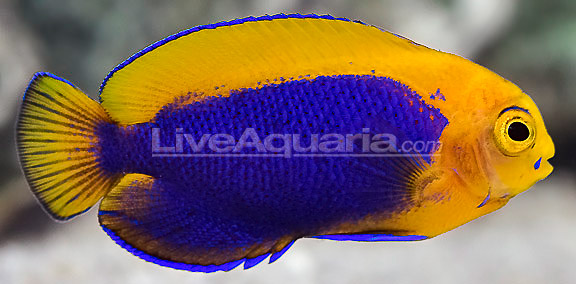
Frank Baensch and Reef Culture Technologies continued to forge ahead in 2012. Perhaps most notable was the introduction of a new captive bred hybrid pygmy angelfish, the “Resplendent Cherubfish”, a crossing between Centropyge argi and C. resplendens.
Baensch continued to refine his larval rearing techniques in 2012, working with wild-collected spawn to rear numerous exotic and random species of marine fish. While technically not “captive-bred”, these are certainly proof of concept that we are rapidly approaching a time when many more marine fish can be spawned and reared successfully in captivity.
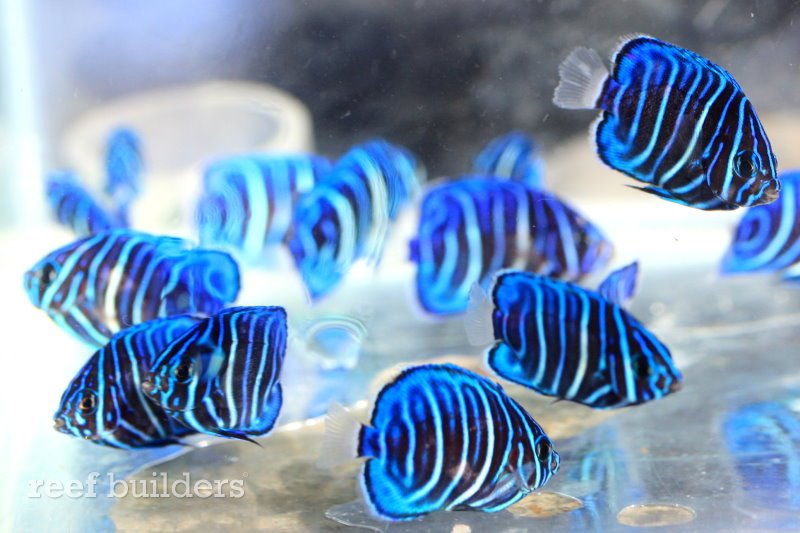
The Annularis Angelfish, Pomacanthus annularis, officially entered our list of captive-bred species in 2012, and it’s some matter of debate as to who may have actually achieved this feat first. Both Rising Tide and then Bali Aquarich shared news with the species in 2012. With Rising Tide focusing on research, Wen Ping Su and Bali Aquarich are now providing a steady supply of captive-bred Annularis Angelfish into the market, so much so that Just before 2013, LiveAquaria made the captive-bred Annularis Angel a routine item offering on their website – a sign that a steady supply of these fish are there for you, the conscientious aquarist, to purchase!
Of course, Bali Aquarich has been breaking ground on many levels, and another area where we’re seeing progress is in the designer clownfish field. It’s fair to say that they may have led the way in 2012, giving us glimpses of Galaxy Clarkii Clownfish, and endless stream of unique Picasso Perculas, and what is probably the first designer variant of Amphiprion sebae, in the “Picasso” Sebae Clownfish. There are promising signs that we’ll see our first captive-bred variant of Amphiprion polymnus as well, in the form now dubbed the “White Horse” Saddleback. While this form emerged a few years back, good numbers were seen in 2012, and that bodes well for more in the future. Sustainable Aquatics made headway by making the first commercial scale offerings of captive-bred Allardi Clownfish (A. allardi), as well as touting the return of the unique Wyoming White Ocellaris variant, offering a discerning aquarist an alternative to the ubiquitous, and similar, Platinum Percula variant (A. percula).

Speaking of the Wyoming White Ocellaris, we cannot review the year in breeding without mentioning the passing of Bill Addison and not much later in 2012, his wife Arline. Bill, the founder of C-Quest Hatcheries, and was responsible for bringing us not only the Wyoming White, but also the ubiquitous “C-Quest” line of captive-bred Onyx Percula. And speaking of Onyx Percula from the C-Quest line, the breeding community and clownfish enthusiasts alike also mourned the loss of Mamma Onyx, the founding female of the Rod’s Onyx line of breeding, all traceable back, ultimately, to Bill Addison’s C-Quest. Nevertheless, the Addisons’ legacy will live on in the many clownfish that can, to this day, trace their lineage back to C-Quest.

Aquarists continued to drive demand for things like “Black Ice” Clownfish in 2012. All this ornamental breeding has led to fish like the Sea & Reef “Phantom” Clownfish, which is undeniably similar to ORA’s “Black Snowflake” and probably shares a very similar, if not exactly identical, genetic makeup, a cocktail all leading back to the black “Darwin Ocelalris” and the “Snowflake” Ocellaris. The name game rages on, with Sea & Reef producing Wyoming Whites, but also re-emphasizing their “Maine Blizzard”, Sea & Reef’s all-white A. percula.

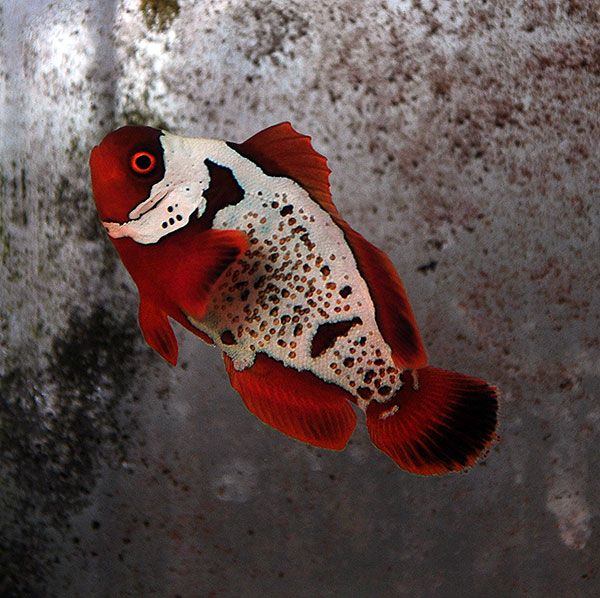
While variations and hybrids of both the Percula and Ocellaris clownfish continue to take center stage, 2012 also showed great strides within the genus Premnas. Designer Maroon Clownfish vied for the spotlight, with the well -known Lightning Maroon successfully reproducing and demonstrating that the Lightning trait is definitively genetic, and inheritable. The genetic mystery remains, as the 50/50 split in the F1 generation is a possible outcome for all types of expression, be it recessive, partially dominant, or a dominant trait. As the limited number of offspring are ready for release, we could, as early as late 2013 (but probably more like 2014 or 2015), know the answers.

Meanwhile, ORA took another look at the “Goldflake” Maroon phenomenon as seen in most Sumatran Gold Stripe Maroon breeding efforts, and as it turned out these “goldflake” variations may not be simple misbars or random overbars, but perhaps do have a genetic basis after all The result of this shifted mindset was commercial availability of Goldflake Maroons, but also the discovery of Solid Gold Maroons, which of course, start out white, and then the white areas turn gold as the fish matures.

No doubt, many wannabe breeders have been going crazy with dreams of getting their hands on some ORA Goldflakes and a Lightning or two and frankenstiening the next generation of unique Maroon clownfish variations. This author would like to strongly discourage that; at this time both designer lines of Maroon clownfish remain distinct and traceable back to their native waters. Maintaining this provenence has redeeming conservation merits. More importantly and along those lines, not everyone agrees that the Gold Stripe Maroon Clownfish, and the White Stripe Maroon Clownfish, are even the same species.
Much like Amphiprion pacificus was once considered a population of A. akallopisos, or A. barberi was once A. melanopus and before that A. rubrocintus, so too we may find that genetic testing could one day provide a solid basis for the differentiation that’s already starkly apparent between Gold Stripe Maroons and their White Stripe counterparts. Black Ocellaris, vs. the standard Orange Ocellaris, are another currently “lumped” group where some breeders, based on their experiences of different reproductive biology, believe suggestive that we may be dealing with two species vs. one.
With at least one commercially produced strain of a “species” having dubious provenence and/or purity, breeders are starting to take a page from the freshwater trade where provenance (collection) data is vital. With the ever-growing threats to the wild-harvest of marine aquarium fishes, breeders ought to be looking towards species preservation, as well as the preservation of provenence and individual geographic variations, as a priority in 2013 and beyond.
In this regard, Sustainable Aquatics led the trade in 2012, working with unique forms of standard species, such as the New Caledonia Blue Stripe Cinnamon Clownfish (A. melanopus), the same geographic provenence of ORA’s staple Melanopus. However, Sustainable Aquatics also now offers the rare polymorophic form (also A. melanopus), where individual fish may, or may not, have a headstripe! As we become more aware of the unique varieties of natural clownfish species, I can only hope to see the same enthusiasm over subtle differences between a “Black Ice” and a “Black Snowflake” be carried over for naturally occurring variants like the “White Tailed” Solomon Islands form of the Cinnamon Clownfish.
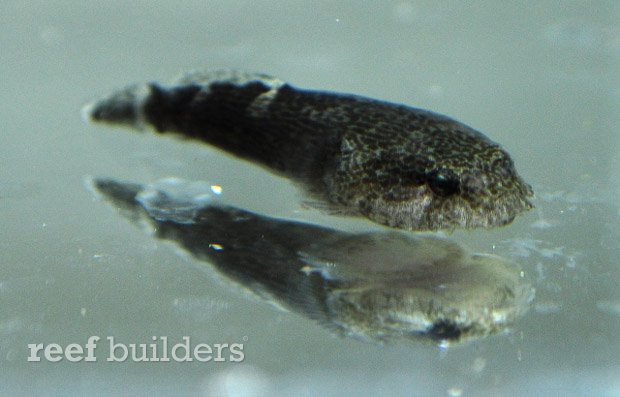
And so too, breeding news isn’t always about the next blockbuster clownfish or stunning species. Sometimes, commercial breeders make progress with lesser known forms. While the species first arguably goes to Matthew L. Wittenrich, Sustainable Aquatics can lay claim to being the first to produce commercial quantities of captive-bred Molly Miller Blennies. Ironically, we also saw the almost haphazard successful rearing of Molly Millers by Houston breeder Mike Hoang (perhaps better known for some stunning Goldflake Maroons he produced). Even the lowly Stippled Clingfish got some press in 2012, being offered commercially by Sustainable Aquatics.

The rising availability and diversity of commercial offerings in 2012 is perhaps one of the high points for the year. We saw the return of captive-bred Marine Bettas by Sustainable Aquatics.

A once-ubiquitous hybrid cleaner goby produced by ORA made it’s return in 2012 as well.
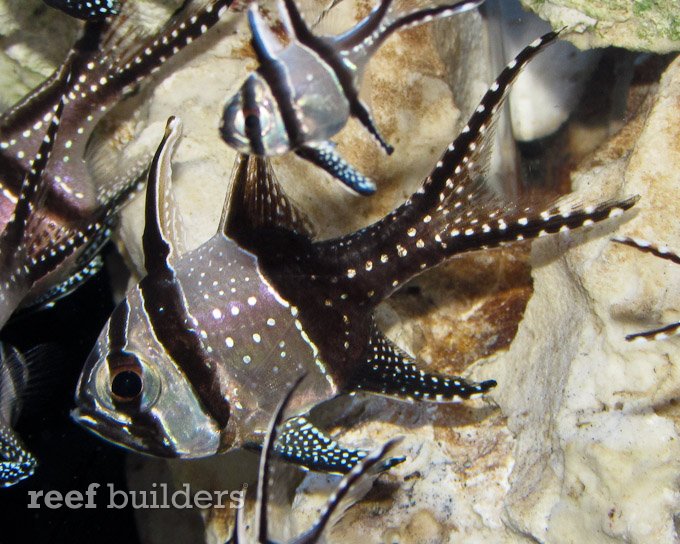
We saw massive community support for furthering captive breeding with the support of the ongoing Banggai Rescue project, but Banggai Cardinalfish (Pterapogon kauderni) made big news already in 2012. Not only did a massive new commercial supply of captive-bred Banggai Cardinalfish come online in 2012, but my own research into the genetics requirements of conservation breeding revealed that the best way to ensure a stable captive population of Banggais is that all consumers of Banggai Cardinals, be it hobbyist or breeder, ought to purchase from large scale commercial breeders. The mathematics don’t lie – large scale commercial culture can easily hit the “Platinum” standard for genetic maintenance at a species conservation level….it’s far more realistic at this level than when looking at the hobbyist-scale approach.
With a steady, available supply of captive-bred Banggais now at hand, it falls to you, the end consumer, to make the right choice and vote with your wallet rather that continue to purchase this endangered species (per IUCN Red List) as a wild caught fish. Of course, some retailers have taken the responsible step for you, and are now offering only captive bred Banggais. Meanwhile, fans of designer morphs were delighted with the discovery of what has been dubbed a “Panda Banggai”, outwardly looking like a half-black fish (there are Half Black Guppies, Half Black Angelfish, and now…a half-black Banggai). With captive breeding finally really taking off for this species after years of outcry for it, who knows what other unique variations might arise out of captive culture?
Of course, 2012 was not without a landslide of species firsts we didn’t already mention. They ranged from the bold to the rather superficially mundane in terms of aesthetics, but every new species was a victory for the marine aquarium industry and hobby.

We are certainly seeing the benefit of more diverse copepod offerings from Algagen. We knew it was going to happen, it was just going to take someone to demonstrate the possibilities of these feeds. Intrepid breeder Todd Gardner hit home runs with two species of Damselfish, both the Bowtie Damsel but more excitingly, a species first in the Barrier Reef Chromis, Chromis nitida. Another damselfish first came for the Rising Tide Initiative and Stienart Aquarium, with the Ternate Damselfish being reared in a cross-country, FedEx facilitated collaboration!

Todd Gardner also made waves in 2012 beyond Damselfish. Best know for his successes with Liopropoma, Gardner also notched our collective bedpost with Lipogramma klayi, a rare, deepwater species who likely won’t ever have much commercial availability unless it is brought into large scale commercial culture. Gardner has gotten us one step closer to that future possibility.

One of the most exciting firsts that literally went almost completely unnoticed happened in the aquariums at Proaquatix. A rather nondescript species of “goby” found its way to Proaquatix and was then successfully bred…all without the folks there even knowing what species it is. It turned out to be a Parioglossus species, a Dartfish. It’s pretty little schooling fish (already a nice plus in a world where most marine fish are territorial or at least anti-social to some degree). However, it is noteworthy for a much more important reason – it’s a relative of the Firefishes. In no uncertain terms, Proaquatix took one step closer towards the eventual breeding of perhaps a Nemateleotris species, maybe even the coveted Helfrichi Firefish. This is how it happens folks…we chip away at it, we attack from all sides.

Sometimes, attacking from all sides can mean simply trying to rear any eggs you can get your hands on, which is how Rising Tide wound up rearing captive-spawned Orbic Batfish (Platax orbicularis).

Rising Tide has truly brought forth MANY advances since its inception. We should remember to credit Judy St. Leger for starting the project that gave a home to folks like Matthew L. Wittenrich, and Eric Cassiano, where they could focus on breaking new ground, and then sharing that information back with the community at large. Truly, a Rising Tide raises all ships…especially when they do things like publish a tell-all on how to rear grunts! Revelations like the fact that Pomacanthus semicircularis only takes 26 or so days to reach settlement give new hope that hobbyists can actually tackle what we consider “challenging” species on their own.
That’s exactly what Karen Brittain did, wowing the world this winter with news of the first successful captive breeding of Genicanthus wantanabae. Brittain remains the only person in the world to have reared any Genicanthus angelfish, her first success being the extremely rare Genicanthus personatus some years back. Brittain is also known for being one of the best producers of captive-bred Latezonatus Clownfish (Amphiprion latezonatus), and is generally quite straightforward in her approach. Brittain released some early details on her process in the Jan/Feb 2013 edition of CORAL Magazine; in truth, Brittain doesn’t seem to keep secrets, and her willingness to share her methodology makes here an incredible asset to us all.
Indeed, when it comes to breeding a new species, sometimes there just really isn’t a secret. Sometimes, what it really takes is simply getting your hands on it in the first place. All it took was for ORA to get their hands on a group of the very rare Randall’s Assessor (Assessor randalli) – probably wasn’t even a year and they’ve announced success with the species late in 2012!

Then again, sometimes success comes out of left field, catching everyone off guard. So much of our knowledgebase is simply determined by the information being made available in the first place. Only at the very end of 2012 did the news break of the successful breeding of the Finespotted Jawfish (Opistognathus punctatus) by Kentaro Amemiya at the Tokyo Sea Life Park. Yet, as we come to learn in the story, his first successes actually occurred in 2010!
Which leaves us to ponder as we start 2013, what’s next? For all we know, the next big thing in marine breeding is just starting, a work in progress, or maybe has already even happened! “Photos – or it never happened” seems to be the mantra of late, whether it’s for Marine Breeding Initiative points or the realization that unless you talk about your successes, how will anyone know? Be sure to tell us whenever you stumble across anything breeding related so we can check it out and if appropriate, share it with the world! I’m absolutely sure I missed something in this review…gone are the days when marine fish breeding could easily be kept track of by one person, and that’s a very good change in my opinion.
May 2013 be a very…productive….year for all you fish breeders! And for everyone else, let me remind you that in 2013, the concept of a tank with nothing but captive-bred marine fish is a very real possibility, and with availability on the uptick, you’ll probably have more than 100 species to chose from if you pay attention closely in 2013.


